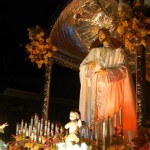Jesus – Idol or Icon?
Jesus – Idol or Icon?
As we arrived at church on Sunday morning in St. Louis this past weekend, my three year old nephew asked my Mom, “Mimi, did God make Jesus or did Jesus make God?” My Mom and I looked at each other and then she quickly answered, “There’s one God with three different jobs” or something to that affect. As I read “The Sacred Gaze” by David Morgan I began to think about Jesus, and the variety of icons and statues that depict him. And it lead me back to my nephews question. I’ll come back to this at the end of this writing.
Morgan discusses a variety of topics surrounding religious visual culture, from the use of statues and icons in Eastern Asian traditions, African traditions and Catholic and Orthodox Christianity,the historical religious education communicated through tracts and magazine images within Protestant Christianity, and the sacred books of Sikhism, Judaism and Islam. He explains, “The power of images, which is the power of the sacred gaze,the power of the way believers behold images and are beheld by them and seek to hold others with them, consists of seeing the countenance of the otherwise intangible…” (4271) In other words, visual imagery for humans help capture the abstract, the concept, the deity. Some would say it is a way that God is compassionate to humans. The visual depictions of God are attractive to our minds and allow us to make sense of God.
In the case of Jesus, Christians believe God robed itself in flesh and became a male being that could live the way, speak the truth and live the life that God desired humanity to experience. Christians believe that Jesus is God while Jews and Muslims do not, and instead hold to the maxim of the One God that is too sacred to see. While Jews and Muslims do not make images of God, Christians have numerous art pieces of Jesus, God in the flesh.
By having a God in flesh Morgan explains that iconoclasm is merely removing one image to replace it with another. By juxtaposing this idea with another, that of the history of Christian doctrine which has been “…a history of vehement disagreement and struggle to legitimate one belief and deny the legitimacy of another,” we can see why Christianity, in general, has been an exclusionist organized movement.(289) In fact, the very denial of Jesus as God would be to the demise of the complete religion. Therefore, why is an image of God, which most Christians would agree Jesus was, be such a threat to the Protestant Christian movement? Is it a hypocritical stance for iconoclasts to believe that Jesus is God while denying the images and statues of Jesus? Morgan briefly addresses this idea by stating,”The creedalist notion of belief argues that speaking is more powerful as an expression of faith than seeing.” (342) And yet, as he also explains, “Practice is far more constitutive of belief than creedal affirmation is.” (293) If God, through compassion, became a visual image so that humanity could experience him, then is it wrong that human beings desire to make images of God? If God realizes that humans need a form in order to understand the abstract then why must forms be controversial? If an idol is something of inherent worth without relation to anything outside of itself, can we say that Jesus has become an idol? Or, was Jesus an icon, a type of “pointer” to God?
How should we answer my three year old nephew’s question, “Did God make Jesus or did Jesus make God?” Perhaps we could answer, “both.” God made himself a man and Jesus made clear some of the aspects of God in order to help the human understanding of God.
Or perhaps we should just tell my nephew something similar to what my Mom said, “There’s one God…he comes in three (or more) forms…now come on’ it’s time to go to church.”

Leave a Reply
You must be logged in to post a comment.